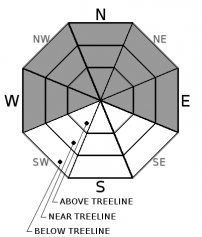| Saturday | Saturday Night | Sunday | |
|---|---|---|---|
| Weather: | Partly cloudy | Clear | Partly cloudy with clouds increasing during the day. Slight chance (20%) of snow showers in the afternoon. |
| Temperatures: | 32 to 37 deg. F. | 16 to 21 deg. F. | 29 to 34 deg. F. |
| Mid Slope Winds: | East | Southwest | Southwest |
| Wind Speed: | 10 mph with gusts to 25 mph in the afternoon | 0 to 10 mph increasing to 10 to 15 mph with gusts to 40 mph after midnight | 15 to 20 mph increasing to 20 to 30 mph with gusts to 50 mph in the afternoon |
| Expected snowfall: | 0 | 0 | up to 1 |
| Saturday | Saturday Night | Sunday | |
|---|---|---|---|
| Weather: | Partly cloudy | Clear | Partly cloudy with clouds increasing during the day. Slight chance (20%) of snow showers in the afternoon. |
| Temperatures: | 31 to 36 deg. F. | 16 to 21 deg. F. | 28 to 34 deg. F. |
| Ridge Top Winds: | East | East shifting to west and southwest after midnight | West to southwest |
| Wind Speed: | 10 to 15 mph with gusts to 35 mph | 10 to 15 mph with gusts to 30 mph increasing to gusts to 55 mph after midnight | 30 to 50 mph with gusts to 85 mph increasing to gusts to 95 mph in the afternoon |
| Expected snowfall: | 0 | 0 | up to 1 |























